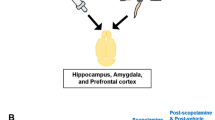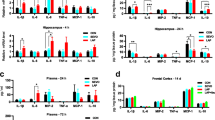Abstract
Delirium is a common complication seen after surgery and anesthesia, in particular in older patients. Although the etiology of postoperative delirium is only incompletely understood, various lines of evidence suggest that proinflammatory signaling from the peripheral site of inflammation to central nervous system results in a decrease of cerebral acetylcholine (ACh) levels thereby inducing neuroinflammation. To corroborate this theory, we applied an animal model for characterization of the neuroinflammatory response after partial hepatectomy (HPx). In this model, the surgery-induced decrease in cerebral ACh levels can be prevented by intraoperative application of physostigmine. Thus, ACh-associated changes in the expression and secretion of inflammation-related compounds can be assessed by comparing the results obtained after surgery, in physostigmine-treated and untreated controls. This way we were able to show that the decrease of cerebral ACh triggers increased secretion of IL-1β, IL-6, TNFα, MIP-2 (CCL3), RANTES, MCP1, IFNgamma, and IP-10. A gene array covering the expression of 370 inflammation-related genes indicated 13 candidates that are induced upon cerebral ACh decrease after HPx. Quantification of the changes in the expression of these candidates by the comparative CT method revealed a significant increase (> 1.5-fold) in the expression of IL-1β, IL-6, TNFα, MIP2, RANTES, MCP1, TLR2, TLR4, HMGB1, TNFSF6, TNFSF12, IL1R1 and ILR6. Thus, our results suggest that peripheral surgery induces a reduction of cerebral ACh levels which trigger a complex neuroinflammatory response. From a clinical point of view, manipulating cerebral ACh levels by procholinergic drugs such as physostigmine could become an option to therapeutically target this kind of neuroinflammation.




Similar content being viewed by others
Abbreviations
- ACh:
-
Acetylcholine
- CNS:
-
Central nervous system
- CSF:
-
Cerebrospinal fluid
- HPx:
-
Partial hepatectomy
- POD:
-
Postoperative delirium
References
Acharya NK, Goldwaser EL, Forsberg MM, Godsey GA, Johnson CA, Sarkar A, DeMarshall C, Kosciuk MC, Dash JM, Hale CP et al (2015) Sevoflurane and isoflurane induce structural changes in brain vascular endothelial cells and increase blood–brain barrier permeability: possible link to postoperative delirium and cognitive decline. Brain Res 1620:29–41
Asthana S, Greig NH, Hegedus L, Holloway HH, Raffaele KC, Schapiro MB, Soncrant TT (1995) Clinical pharmacokinetics of physostigmine in patients with Alzheimer’s disease. Clin Pharmacol Ther 58:299–309
Basu A, Krady JK, Levison SW (2004) Interleukin-1: a master regulator of neuroinflammation. J Neurosci Res 78:151–156
Bolin LM, Murray R, Lukacs NW, Strieter RM, Kunkel SL, Schall TJ, Bacon KB (1998) Primary sensory neurons migrate in response to the chemokine RANTES. J Neuroimmunol 81:49–57
Cerejeira J, Firmino H, Vaz-Serra A, Mukaetova-Ladinska EB (2010) The neuroinflammatory hypothesis of delirium. Acta Neuropathol 119:737–754
Chavan SS, Pavlov VA, Tracey KJ (2017) Mechanisms and therapeutic relevance of neuro-immune communication. Immunity 46:927–942
Cho J, Nelson TE, Bajova H, Gruol DL (2009) Chronic CXCL10 alters neuronal properties in rat hippocampal culture. J Neuroimmunol 207:92–100
Conductier G, Blondeau N, Guyon A, Nahon JL, Rovere C (2010) The role of monocyte chemoattractant protein MCP1/CCL2 in neuroinflammatory diseases. J Neuroimmunol 224:93–100
Cortese GP, Burger C (2017) Neuroinflammatory challenges compromise neuronal function in the aging brain: postoperative cognitive delirium and Alzheimer’s disease. Behav Brain Res 322:269–279
Fonken LK et al (2016) The alarmin HMGB1 mediates age-induced neuroinflammatory priming. J Neurosci 36:7946–7956
Frank MG, Weber MD, Watkins LR, Maier SF (2015) Stress sounds the alarmin: the role of the danger-associated molecular pattern HMGB1 in stress-induced neuroinflammatory priming. Brain Behav Immun 48:1–7
Guo W, Wang H, Watanabe M, Shimizu K, Zou S, LaGraize SC, Wei F, Dubner R, Ren K (2007) Glial-cytokine-neuronal interactions underlying the mechanisms of persistent pain. J Neurosci 27:6006–6018. https://doi.org/10.1523/jneurosci.0176-07.2007
Holmes GM, Hebert SL, Rogers RC, Hermann GE (2004) Immunocytochemical localization of TNF type 1 and type 2 receptors in the rat spinal cord. Brain Res 1025:210–219
Hshieh TT, Fong TG, Marcantonio ER, Inouye SK (2008) Cholinergic deficiency hypothesis in delirium: a synthesis of current evidence. J Gerontol Ser A 63:764–772
Jiang P, Ling Q, Liu H, Tu W (2015) Intracisternal administration of an interleukin-6 receptor antagonist attenuates surgery-induced cognitive impairment by inhibition of neuroinflammatory responses in aged rats. Exp Ther Med 9:982–986
Kempuraj D, Thangavel R, Natteru PA, Selvakumar GP, Saeed D, Zahoor H, Zaheer S, Iyer SS, Zaheer A (2016) Neuroinflammation induces neurodegeneration. J Neurol Neurosurg Spine 1:1003
Kuno R, Wang J, Kawanokuchi J, Takeuchi H, Mizuno T, Suzumura A (2005) Autocrine activation of microglia by tumor necrosis factor-alpha. J Neuroimmunol 162:89–96
Lanfranco MF, Mocchetti I, Burns MP, Villapol S (2017) Glial- and neuronal-specific expression of CCL5 mRNA in the rat brain. Front Neuroanat 11:137
Lazovic J, Basu A, Lin HW, Rothstein RP, Krady JK, Smith MB, Levison SW (2005) Neuroinflammation and both cytotoxic and vasogenic edema are reduced in interleukin-1 type 1 receptor-deficient mice conferring neuroprotection. Stroke 36:2226–2231
Maldonado JR (2008) Delirium in the acute care setting: characteristics, diagnosis and treatment. Crit Care Clin 24:657–722
Nelson TE, Gruol DL (2004) The chemokine CXCL10 modulates excitatory activity and intracellular calcium signaling in cultured hippocampal neurons. J Neuroimmunol 156:74–87
Nitsch RM, Rossner S, Albrecht C, Mayhaus M, Enderich J, Schliebs R, Wegner M, Arendt T, von der Kammer H (1998) Muscarinic acetylcholine receptors activate the acetylcholinesterase gene promoter. J Physiol Paris 92:257–264
Ottum PA, Arellano G, Reyes LI, Iruretagoyena M, Naves R (2015) Opposing roles of interferon-gamma on cells of the central nervous system in autoimmune neuroinflammation. Front Immunol 6:539
Pavlov VA, Tracey KJ (2015) Neural circuitry and immunity. Immunol Res 63:38–57
Plaschke K, Muller AK, Kopitz J (2014) Surgery-induced changes in rat IL-1beta and acetylcholine metabolism: role of physostigmine. Clin Exp Pharmacol Physiol 41:663–670
Plaschke K, Weigand MA, Fricke F, Kopitz J (2016) Neuroinflammation: effect of surgical stress compared to anaesthesia and effect of physostigmine. Neurol Res 38:397–405
Rada P, Mark GP, Vitek MP, Mangano RM, Blume AJ, Beer B, Hoebel BG (1991) Interleukin-1 beta decreases acetylcholine measured by microdialysis in the hippocampus of freely moving rats. Brain Res 550:287–290
Rudolph JL, Ramlawi B, Kuchel GA, McElhaney JE, Xie D, Sellke FW, Khabbaz K, Levkoff SE, Marcantonio ER (2008) Chemokines are associated with delirium after cardiac surgery. J Gerontol Ser A 63:184–189
Schall TJ (1991) Biology of the RANTES/SIS cytokine family. Cytokine 3:165–183
Schmittgen TD, Livak KJ (2008) Analyzing real-time PCR data by the comparative C(T) method. Nat Protoc 3:1101–1108
Shaftel SS, Carlson TJ, Olschowka JA, Kyrkanides S, Matousek SB, O’Banion MK (2007) Chronic interleukin-1beta expression in mouse brain leads to leukocyte infiltration and neutrophil-independent blood brain barrier permeability without overt neurodegeneration. J Neurosci 27:9301–9309
Shytle RD, Mori T, Townsend K, Vendrame M, Sun N, Zeng J, Ehrhart J, Silver AA, Sanberg PR, Tan J (2004) Cholinergic modulation of microglial activation by alpha 7 nicotinic receptors. J Neurochem 89:337–343
Skrede K, Wyller TB, Watne LO, Seljeflot I, Juliebo V (2015) Is there a role for monocyte chemoattractant protein-1 in delirium? Novel observations in elderly hip fracture patients. BMC Res Notes 8:186
Sonar S, Lal G (2015) Role of tumor necrosis factor superfamily in neuroinflammation and autoimmunity. Front Immunol 6:364
Steiner LA (2011) Postoperative delirium. Part 1: pathophysiology and risk factors. Eur J Anaesthesiol 28:628–636
Taepavarapruk P, Song C (2010) Reductions of acetylcholine release and nerve growth factor expression are correlated with memory impairment induced by interleukin-1beta administrations: effects of omega-3 fatty acid EPA treatment. J Neurochem 112:1054–1064
Terrando N, Yang T, Ryu JK, Newton PT, Monaco C, Feldmann M, Ma D, Akassoglou K, Maze M (2014) Stimulation of the α7 nicotinic acetylcholine receptor protects against neuroinflammation after tibia fracture and endotoxemia in mice. Mol Med 20:667–675
Tripathy D, Thirumangalakudi L, Grammas P (2010) RANTES upregulation in the Alzheimer’s disease brain: a possible neuroprotective role. Neurobiol Aging 31:8–16
van Gool WA, van de Beek D, Eikelenboom P (2010) Systemic infection and delirium: when cytokines and acetylcholine collide. Lancet 375:773–775
Whitlock EL, Vannucci A, Avidan MS (2011) Postoperative delirium. Minerva Anestesiol 77:448–456
Zujalovic B, Barth E (2015) Delirium accompanied by cholinergic deficiency and organ failure in a 73-year-old critically ill patient: physostigmine as a therapeutic option. Case Rep Crit Care 2015:793015
Acknowledgements
The expert technical assistance of Roland Galmbacher, Klaus Stefan and Sigrun Himmelsbach is gratefully appreciated. We also acknowledge financial support by Dr. Franz Köhler Chemie, Bensheim, Germany.
Funding
This study was supported by a research fund from Dr. Franz Köhler Chemie GmbH (Bensheim, Germany).
Author information
Authors and Affiliations
Corresponding author
Electronic supplementary material
Below is the link to the electronic supplementary material.
Rights and permissions
About this article
Cite this article
Plaschke, K., Schulz, S., Rullof, R. et al. In-depth characterization of the neuroinflammatory reaction induced by peripheral surgery in an animal model. J Neural Transm 125, 1487–1494 (2018). https://doi.org/10.1007/s00702-018-1909-x
Received:
Accepted:
Published:
Issue Date:
DOI: https://doi.org/10.1007/s00702-018-1909-x




